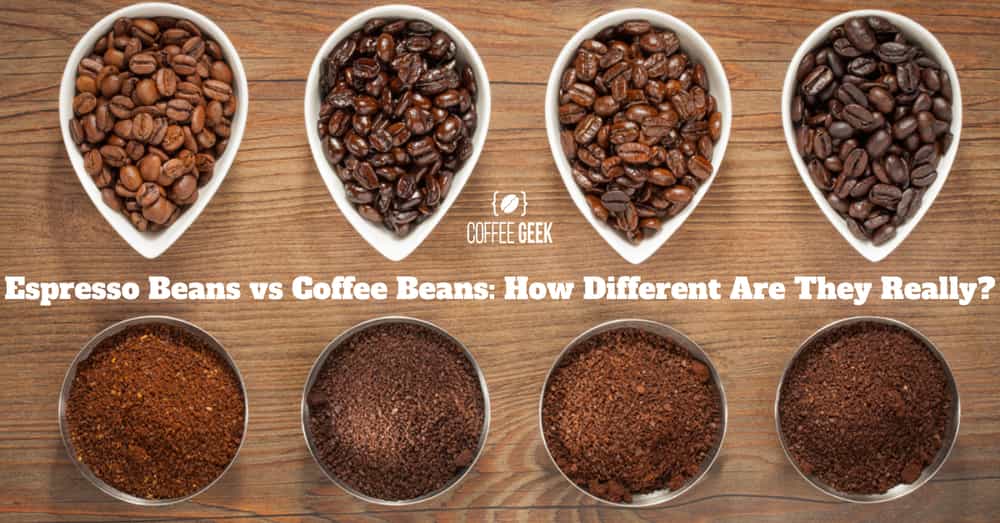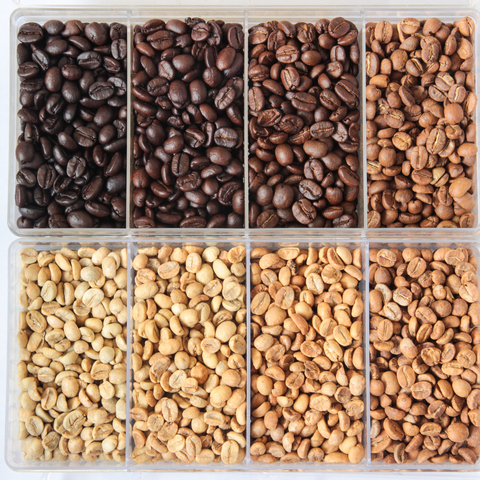If you love coffee, you might have wondered: Are espresso beans different than regular coffee beans? The answer isn’t as simple as you think.
You see, espresso isn’t a type of bean—it’s a way of brewing coffee. But does that mean the beans you use for espresso should be special? What impact does the bean choice have on the taste, aroma, and crema of your shot?
Whether you’re a casual sipper or a budding home barista, understanding these differences can transform how you enjoy your coffee. Keep reading to uncover the truth behind espresso beans versus regular coffee beans—and learn how to make your perfect cup every time.

Credit: lifeboostcoffee.com
Espresso Beans Vs Regular Beans
Espresso beans and regular coffee beans often seem different. Many believe they come from separate plants. Actually, both come from the same coffee species. The difference lies in how they are roasted, selected, and prepared for brewing. Understanding these differences helps you choose the right beans for your coffee style.
Roast Levels And Profiles
Espresso beans usually have a darker roast. This brings out a strong, bold flavor. Dark roasts reduce acidity and add a smoky, rich taste. Regular coffee beans have more variety. They can be light, medium, or dark roasted. Light roasts keep more original bean flavors. Medium roasts balance acidity and body. Dark roasts give deeper, heavier notes. The roast level affects how the beans taste in your cup.
Bean Origin And Selection
Espresso blends often combine beans from different origins. This mix creates a balanced flavor with body and crema. Roasters pick beans with complementary characteristics. Regular coffee beans are usually single-origin or simpler blends. They highlight specific regional flavors. The origin affects acidity, sweetness, and aroma. Espresso beans focus on a consistent, rich cup. Regular beans offer more flavor variety.
Oil Content And Freshness
Espresso beans tend to have more surface oil. The dark roast brings oils to the surface, adding shine. These oils help create crema, the espresso’s foam layer. Freshness is crucial for both types. Fresh beans keep their oils and flavors intact. Stale beans lose oils and taste flat. Grinding espresso beans right before brewing preserves freshness and oil content. This ensures a smooth, flavorful espresso shot.

Credit: coffeegeek.tv
Brewing Methods Impact
The way coffee is brewed changes how beans taste and feel. Different brewing methods pull out different flavors and strengths from the beans. This means espresso beans and regular coffee beans can taste very different, even if they come from the same source. Understanding these brewing methods helps explain why espresso beans seem unique.
Espresso Machine Extraction
Espresso machines use high pressure to force hot water through finely ground coffee. This fast extraction takes about 25-30 seconds. The pressure pulls oils and flavors quickly, creating a thick, rich shot with crema on top. Espresso beans are usually roasted darker to handle this intense process and to bring out bold flavors. The fine grind is key for proper extraction and to avoid bitterness.
Drip And Other Methods
Drip coffee makers and other methods like French press or pour-over use gravity or immersion. These methods take longer to brew, usually several minutes. The grind size is coarser than espresso. The water extracts flavors slowly, which brings out lighter, more delicate notes. Regular coffee beans are often roasted lighter or medium to keep these bright flavors. These methods produce a cleaner and less intense cup.
Effect On Flavor And Strength
Espresso brewing creates a strong, concentrated coffee shot. It has a fuller body and thicker texture. The flavor is intense and can be bitter or smoky. Regular coffee brewed by drip or other methods tends to be lighter and less strong. It shows more acidity and complex aroma. Using espresso beans in drip coffee can taste too dark or harsh. Using regular beans for espresso may lack depth and crema.
Flavor Differences
Espresso beans and regular coffee beans differ notably in flavor. These differences come from roasting levels, bean blends, and brewing methods. Espresso beans often have a darker roast, which changes the taste experience. Understanding these flavor differences helps you choose the best beans for your drink.
Acidity And Bitterness
Espresso beans usually have lower acidity than regular coffee beans. Dark roasting reduces acid, making espresso taste smoother. Bitterness is more pronounced in espresso, adding depth. Regular coffee beans, especially light roasts, have brighter acidity and milder bitterness. This contrast shapes the overall flavor of each cup.
Body And Mouthfeel
Espresso has a thicker body and richer mouthfeel. The dark roast and fine grind create a dense, syrupy texture. Regular coffee tends to be lighter and thinner in feel. This difference comes from the brewing pressure and extraction time. Espresso feels fuller and more intense on the palate.
Crema Formation
Crema is the golden foam on top of an espresso shot. It forms from oils and gases released during brewing. Espresso beans, often freshly roasted and oily, create thick crema. Regular coffee beans may produce little or no crema. The presence of crema enhances texture and flavor perception in espresso.
Using Regular Beans For Espresso
Using regular coffee beans for espresso is possible and common. Espresso is a brewing method, not a specific bean type. Regular beans can work well with the right preparation. Expect a different flavor profile compared to beans labeled “espresso.” You may notice more acidity and less boldness. Freshness and grind size play key roles in making good espresso from regular beans.
Grind Size Importance
Grind size affects how water flows through coffee grounds. Espresso needs a very fine grind, almost like powdered sugar. Too coarse a grind leads to weak, watery espresso. Too fine can cause over-extraction and bitterness. Adjust grind size carefully for a balanced shot. Consistency in grind ensures even extraction and better taste.
Bean Quality And Freshness
High-quality beans produce richer espresso flavors. Fresh beans have more oils that create crema and aroma. Old or stale beans give flat, dull espresso. Buy beans roasted within the last two weeks. Store them in airtight containers away from light and heat. Freshness improves both taste and crema formation.
Tips For Optimal Extraction
Use about 18-20 grams of ground coffee for a double shot. Tamp grounds evenly to avoid channeling water. Use water heated to 90-96°C (194-205°F) for best flavor. Extract espresso within 25-30 seconds for balance. Clean your espresso machine regularly to prevent buildup. These steps help get the most flavor from regular beans.
Choosing The Right Beans
Choosing the right beans is key to a great espresso or coffee experience. Beans vary in roast, origin, and flavor. These factors affect the taste and strength of your brew. Understanding different beans helps you pick what suits your preference and brewing style.
Espresso often calls for specific beans to bring out bold and rich flavors. Regular coffee beans can work too, but the results differ. Let’s explore how roast levels and blends influence your coffee.
Dark Roasts For Espresso
Dark roasted beans are common for espresso. They have a strong, bold flavor and low acidity. The roasting process brings out oils that create a creamy crema on top of your shot. Dark roasts help balance the intense pressure of espresso machines. They deliver a rich, full-bodied taste that many espresso lovers enjoy.
Light And Medium Roasts Uses
Light and medium roasts work well for drip or pour-over coffee. They keep more of the bean’s original flavors and acidity. These roasts highlight fruity, floral, and bright notes. Using them for espresso can result in a sharper, more complex flavor. Some prefer this style for a lighter espresso experience.
Experimenting With Blends
Blends combine beans from different origins or roast levels. They aim to balance flavor, acidity, and body. Espresso blends often mix dark and medium roasts. This creates a smooth and layered cup. Trying different blends helps you discover unique tastes. It’s a fun way to customize your coffee to your liking.
Common Myths About Espresso Beans
Many people hold strong beliefs about espresso beans. Some think espresso beans are a special type of coffee bean. Others assume espresso is always stronger than regular coffee. These common myths often confuse coffee lovers. Let’s clear up some of these ideas to understand the truth about espresso beans.
Are Espresso Beans Special?
Espresso beans are not a unique species of coffee. They are the same beans used for regular coffee. The difference lies mostly in the roasting process. Espresso beans tend to be roasted darker to bring out bold flavors. But any bean can be used for espresso brewing. The term “espresso beans” is more about marketing than the bean itself.
Strength Comparisons
Many believe espresso is stronger than regular coffee. This is partly true but depends on serving size and brewing style. Espresso is a small, concentrated shot of coffee. It has more caffeine per ounce but less caffeine per serving than a cup of drip coffee. Strength perception comes from the intense flavor, not just caffeine content.
Impact Of Brewing Technique
Brewing technique plays a big role in coffee taste. Espresso uses high pressure to extract flavors quickly. This creates a rich, creamy texture with a strong aroma. Regular coffee uses slower methods like drip or pour-over. These produce a lighter, smoother cup. The same beans taste different depending on brewing style.

Credit: parachutecoffee.com
Frequently Asked Questions
Can I Use Regular Coffee Beans For Espresso?
Yes, you can use regular coffee beans for espresso. Espresso is a brewing method, not a bean type. Grind beans very fine and use fresh, high-quality beans for best flavor. Regular beans may produce less bold, more acidic espresso with less crema.
Experiment to find your preferred taste.
Does Espresso Coffee Use Different Coffee Beans?
Espresso uses the same coffee beans as regular coffee. The difference lies in the roasting and grind size for espresso brewing.
Are Espresso Beans Stronger Than Regular Beans?
Espresso beans are not inherently stronger than regular beans. The strength depends on roast level and brewing method. Espresso beans usually have a darker roast, producing a bolder, richer flavor. Regular beans can be used for espresso but may yield a lighter taste with more acidity.
Are Espresso Beans Just Dark Roast Coffee?
Espresso beans are not just dark roast coffee. They can be any roast but are often dark for bold flavor. The key difference is in the brewing method, not the beans. Espresso beans are ground finer for pressure extraction, enhancing richness and crema.
Conclusion
Espresso beans and regular coffee beans are not very different by nature. The main difference lies in the roasting level and intended brewing method. Espresso beans are usually darker roasted for a bolder taste and better crema. Regular coffee beans can work for espresso but may taste lighter or more acidic.
Grinding size and freshness matter a lot for good espresso. Trying different beans and roasts helps find your perfect cup. Ultimately, both types can make great coffee when prepared well. Enjoy exploring flavors and brewing styles to suit your taste.
